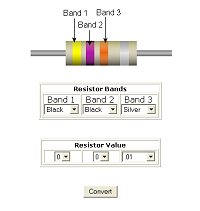Resistors role in the electronic world is to limit the flow of current and voltage division. Resistors are measured in ohms, and
their measurments can be be from under 1 ohm to over 100,000,000 ohms. Resistors use a color coding
system to show the value of each one. For more information on this color coding system and a handy guide go
here.

Resistors are available in several different types. For most projects we will only be interested in the most
common types. Figure 1 shows 3 different types of resistors. The resistors on the left show the standard
resistor. The center picture shows a couple of circuit board mount potentiometers, while the picture on the
right shows a larger potentiometer. Potentiometers are variable resistors, and are commonly know as
"pots". If you have ever adjusted a volume knob on a tv or radio then this was probably a pot.
Since resistors limit current they also produce heat. Because of this resistors also have a wattage rating,
which tells how thier power rating. The most important thing here is to always use a resistor which meets or
exceeds the power requirements required in a project. You can go larger with the power rating, just don't go
lower. For most electronic projects resistors with a 1/4 or 1/2 watt rating are the norm and are the most
common type you will run across.
Figure 2, shows the how resistors are shown on a schematic.

Schematic Symbol for Resistor

Schematic Symbol for Potentionmeter
(Variable Resistor)
Figure 2
Ohms Law

If there is one formula you learn in electronics it should be Ohm's Law. Knowing the fundementals of what
current and voltage are doing in a circuit is the first step in actually understanding what is happening
in a circuit.
Let's say you have a very simple circuit. It includes a battery which is 1.5 volt, and a resistor which is
1K ohms. What we would like to know is what the current (current is measured in amps) will be through this
circuit. We know the voltage, and we know the resistance, and by using Ohm's Law we can determine the current.
1.5 / 1000 = .0015 amp (or 1.5 mA)
|








